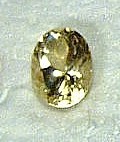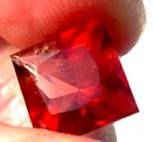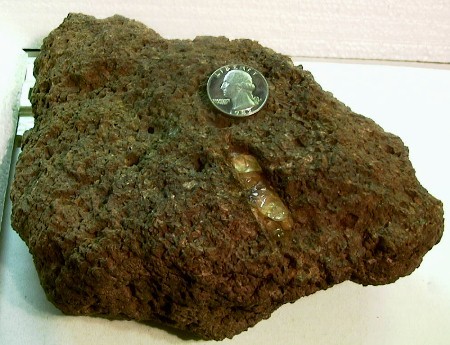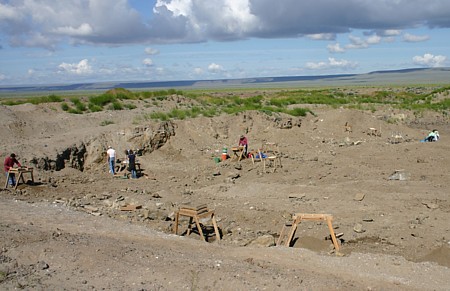
The Beautiful Oregon Sunstone

 |
The Beautiful Oregon Sunstone |
 |
South-Central Oregon has produced some very beautiful gems: The famous Oregon Sunstone. Here is some information......
How
many places in the US can you find good facet & gem quality cabochon material together
in one location, accessible and open to the public for collection with no fee? There are
only a very few places in the US where such materials can be dug, and nearly all are on
private property or under claim. However, in south central Oregon, northeast of Plush, the
BLM has set aside 4 square miles for rock collectors to hunt for sunstones. No claims can
be filled within the BLM sunstone area, and there is no charge to prospect. Even though
thousands of rockhounds have visited this deposit, there are still plenty of stones to be
found. The transparent feldspar gems from this area come in a
variety of colors, including pale yellow, salmon pink, green and the highly desirable
bright red. The area also produces a valuable adventurecent cabochon material with a
bright copper sheen. |
||
| The phenocrysts are distributed
in a fairly random pattern throughout the mother basalt, but the proportion of phenocrysts
to rock does vary here and there, and only a small part are gem quality. In some places the percentage of labradorite is much
greater than the portion of basalt. When these zones weather, they give rise on the
surface to areas 10 to 15 feet in diameter that are completely covered with labradorite
sand. This "sand" consists of small feldspar fragments approximately 1 to 3 mm
in diameter and shimmer brightly in the sun. The crystal fragments can be found in fairly
large sizes. Stones with a maximum dimension of greater than 50 mm can be found.
Unfortunately, most very large fragments such as this have at least one dimension that is
small. This severely limits the size of any large gems that can be attempted. However
fragments capable of cutting light yellow stones to 20 mm are fairly common.
|
 |
|
| In a manner similar
to garnets, the feldspars are a group of different minerals that mix in certain ratios to
form a series of minerals. The three most common pure feldspars are Orthoclase, Albite and
Anorthite. Labradorite is a solid mixture of Albite, which is Sodium feldspar, and
Anorthite, which is Calcium feldspar. Labradorite is a mixture containing 50 to 70 percent
Albite with the remainder being principally Anorthite. In general, labradorite is a little known and underrated
gemstone, yet some of the available colors and types of material are truly beautiful. At a
hardness of 6, it is generally too soft for daily use in rings, it would be acceptable for
occasional wear for special occasions and other types of jewelry. |
||
The adventurine sunstone sheen labradorite from Oregon,
sometimes also known as Heliolite, is of the highest quality. This special effect is
caused by very small inclusions which average 0.1 mm in size. Material from other sources
is similarly colored, but the particles which cause the sheen are much coarser. As a
result the sheen from the Oregon material appears much sharper, more evenly distributed
and does not have the appearance of a rippled texture found in the Indian material. On
very rare occasions, the material from Oregon exhibits a true white moonstone type sheen.
Because of the pale background color, this type of material can be easily missed when
sorting among the other rough. This material is much rarer than the copper colored sheen
material. In cutting the sheen material, care must be taken to properly orient the stone,
so that the base of the cab is parallel to the plane of the sheen. This is critical so
that the sheen shows properly on the top of the stone. Also, the strength of the sheen
varies within the rough, so the material needs to be sawed so that the cab is cut from the
strongest sheen material. Most stones have two planes of sheen, which correlate to the two
cleavage planes of the feldspar. Usually the sheen is one direction is stronger than in
the other. Occasionally, the adventurecent sheen material is cut as a faceted stone. Since
the particles which cause this effect are opaque, these stones are not reflective in the
usual sense. They can however, be very striking. |
 Labradorite Crystal in Basalt |
|
Much of the Labradorite from Oregon is suitable for
faceting. The majority is a pale yellow color, but pink-salmon, greens and reds are also
well known. The facet material varies significantly in quality. Much of the material is at
least slightly sleepy, though this is often so slight as to be hardly noticeable in cut
stones. A lesser portion of the mine run material is very sleepy to muddy, even to the
point of being translucent. However, a large portion of the rough ranges from only very
slightly sleepy to transparent and is well suited to faceting. When inspecting the rough material you collect, it is
important to evaluate the sleepiness of the material, since because of the rough exterior,
the level of transparency is often difficult to gauge. The use of some immersion liquid
such as glycol can be a great assistance. Common inclusions include small crystals of
other minerals and veils of small bubbles. Sometimes the slight sleepiness in some of the material can impart a
grayish cast to the color of the stone. Most of the useful material that is available at Plush is light yellow color facet rough. This type of material will comprise at least 90 percent of the rough recovered from the BLM site at Plush, as well as the adjoining fee dig areas. The colors range from nearly colorless to a hue similar to good yellow beryl. Rough to provide cut stones up to about 20 carats is not unusual. Because the color is light, larger stones show the color better. This material is suggested for practice if the lapidary has not cut labradorite before. |
||
The most highly prized of the facet rough is the bright red.
The red color varies from light to a medium dark shade. When this material is properly cut
it can be very striking. Proper orientation is an important item as the red and green
colors often occur together in the same stone. Color zoning is very common in the red or
green labradorite feldspars. In this material the color usually occurs concentrated in
clots, commonly located near the middle of the stone. The color may occupy 20 to nearly
100 percent of the rough. This means that when the color spot is small, the cutter must
carefully orient the stone so that the color fills the cullet area of the finished gem.
This allows the color to permeate the entire stone when viewed from a face up position.
When selecting rough for purchase, it is important to note a tendency in some red stones
toward muddiness, sleepiness or a brownish color tone. |
 Working in the Sunstone Pit |
|
Pure green stones are less common, but if done well they are attractive in their own right. Another reason that few green stones are seen is that the green is not commonly found without the red color, and the red is usually more desirable. When noting that the red and green coloration often occurs together in the same stone, the reader may be interested in the subject of possible bicolor stones. This is possible with some the rough, but is often very difficult since the color clots exist in irregular shapes and usually tend to wrap partly around each other. Cutting a bicolor without a good separation line along a plane perpendicular to the table, results in color mixing, rather than two individual distinct colors. The mixed red and green is not nearly as attractive. Step cuts such as the standard emerald cut are strongly preferred for any bicolor stones in this material. If you plan a visit to collect at the deposit, the community
of Plush, located about 18 miles from the deposit, is the nearest source of food and gas.
Plush is a small town of not more than about a hundred souls. Be sure to stop in at the
store, as they have a good amount of quality labradorite gems for sale both in cut and
rough form. If nothing else, this will give the first time visitor a chance to see what he
or she is looking for. The nearest town with full service accommodations and supermarkets
is Lakeview, about 60 miles from the deposit. Lakeview is an old lumber town and has the
only active geyser in the state of Oregon. |
||
The last 20 or so miles to the BLM sunstone area is on fair to good dirt roads. In spite of this, however, getting to the Plush site is no problem, as long as long as the roads are not too muddy, and four wheel drive is not necessary. The area is in high desert sagebrush country, and consists of open flats with a few low rolling hills in the area of the deposit. There are many flat open spots suitable for camping at the BLM site. Most of these are suitable for trailers or medium sized motor homes. At the monument sign shown in the picture there are a few picnic tables and an outhouse. The deposit itself spreads over many square miles and goes well beyond the boundaries of the reserved BLM area. Much of the surrounding area is covered by mining claims, so the visitor needs to pay attention near the boundaries of the reserve. Fortunately, the boundaries have been clearly marked by large green painted metal triangles. The
wide open flat country in the BLM rock hound are has many tracks through the sagebrush, inviting the rockhound
to explore. Checking out a variety of areas is worthwhile, because the
character of the labradorite material does from place to place within the deposit.
Because of this, if you find you are not recovering the quality of material you had
expected, you should pick up and move a few hundred yards from your previous location.
Conversely, if you find an exceptional stone, thoroughly check the area within several
feet of the stone you found. There is a good chance you will find additional material. |
 |
|
|
There are two main methods of finding stones at this deposit. The first is by surface hunting better known as "the hunt and peck" method. Many people just walk through the sagebrush and pick up the stones they see. By the same effect which creates "desert pavement" in the Sunstone area, Sunstones are left on the surface when clays, silts, etc. are washed away by rain or blown away by wind. Some good quality stones can be located this way and the only equipment necessary is a good set of eyes. If the sun is out and shining you will see the cleavages and fresh broken surfaces of the stones sparkling in the sunlight. After all the years that rockhounds have been collecting material in this area, it is amazing how much good material is still sitting right on the surface. Using this "hunt and peck" method and looking hard, I have been able to collect an average of over two pounds of mine run rough per day. This is my favorite method of collecting. |
||
|
The other main method for finding stones is by digging and screening. A one quarter inch screen is recommended. When dry, which is most of the time, the soil is fairly free flowing so all that is necessary is to set your screen up on a slant and shovel material into the screen. The usable materials will be found in the screen oversize. It is important to check the oversize rocks and pebbles carefully. Dry dust tends to coat the labradorite and makes it difficult to distinguish from the dust coated basalt pebbles. In fact I make it a policy that whenever I come across piles of coarse screened materials left by a previous prospector, I carefully check the material. I often am rewarded with several nice stones! Be sure if you screen to hold the screen up and look upward through it - you may find some nice stones that way. As you explore around the site you will come across areas of
labradorite sand sparkling on the surface of the soil. Usually every bit of gem material
within that area will be smaller than 3 or 4 mm. A useful suggestion is to check the area
just beyond the perimeter of those circles. Often there are some good stones to be found
there. |
|
|
Want to know a little bit more about this crazy prospector guy? Well, here's a little bit more about me, and how I got into prospecting: Chris' Prospecting Story Interested in seeing more gold? Here are some interesting photos of beautiful Gold Nuggets